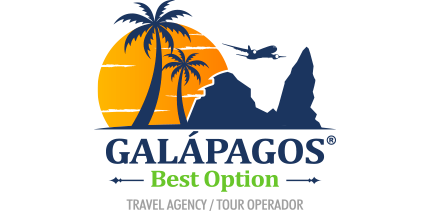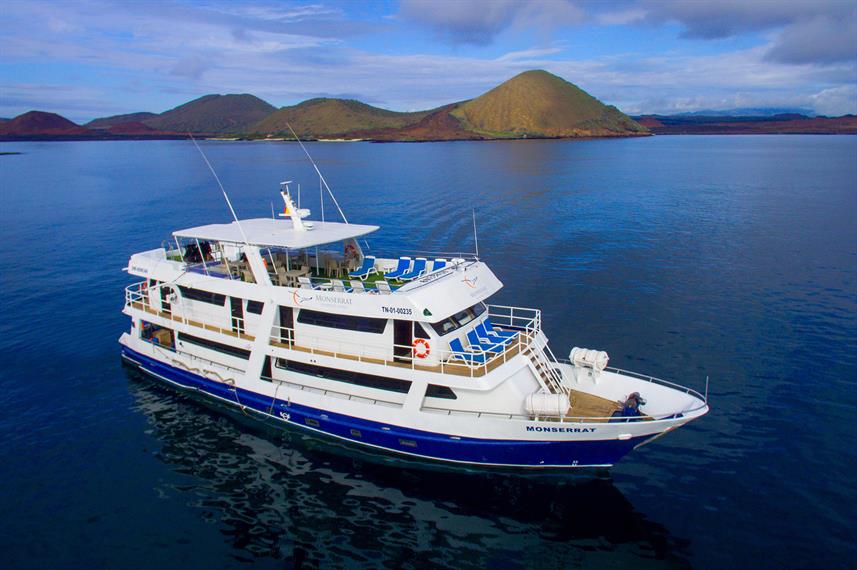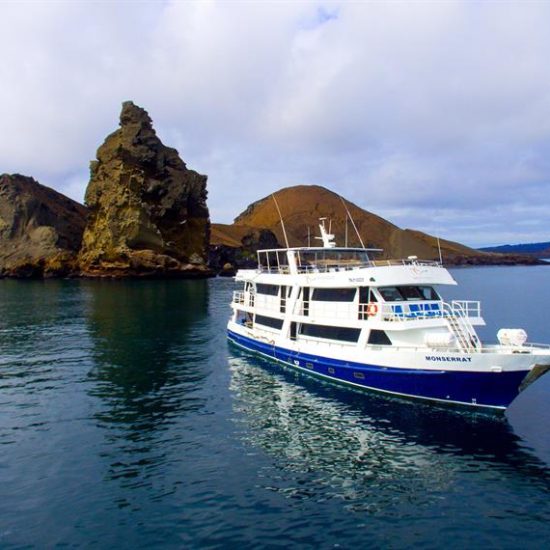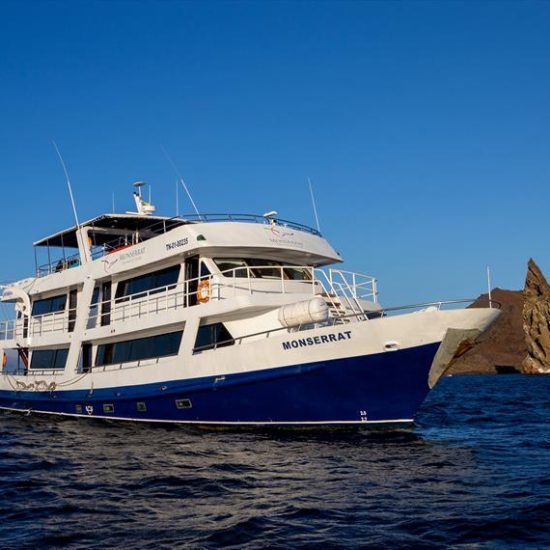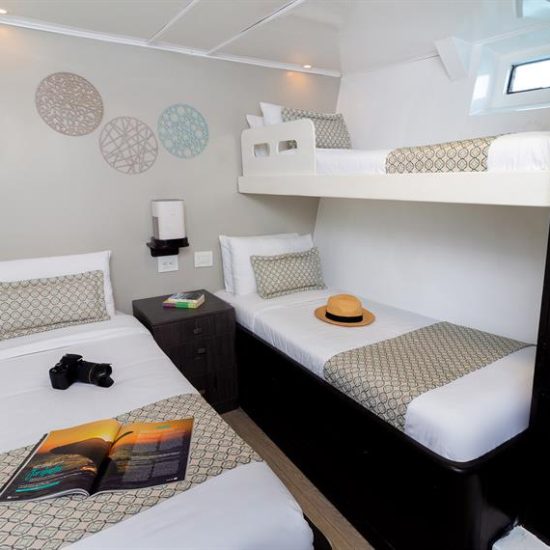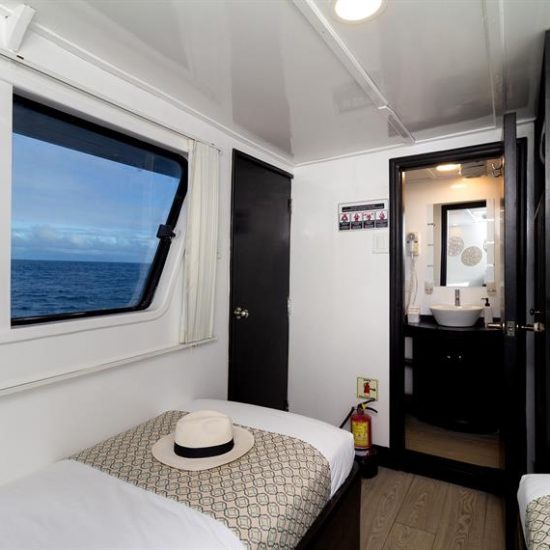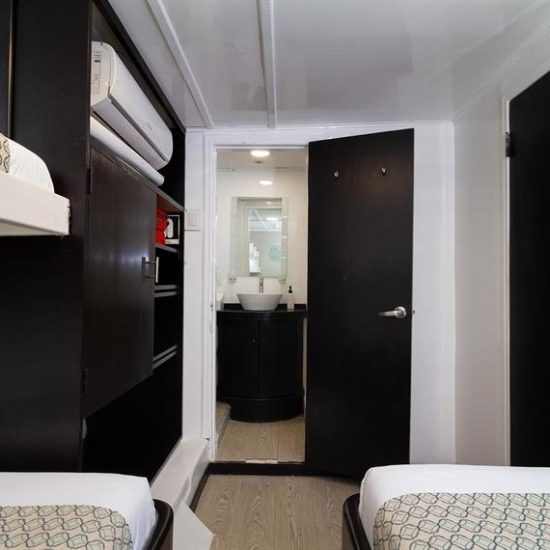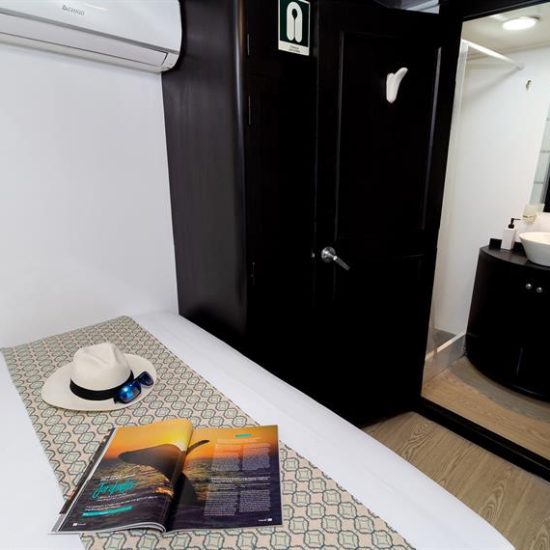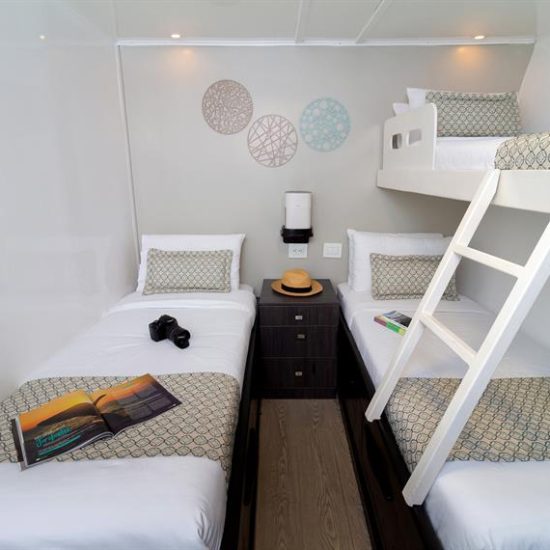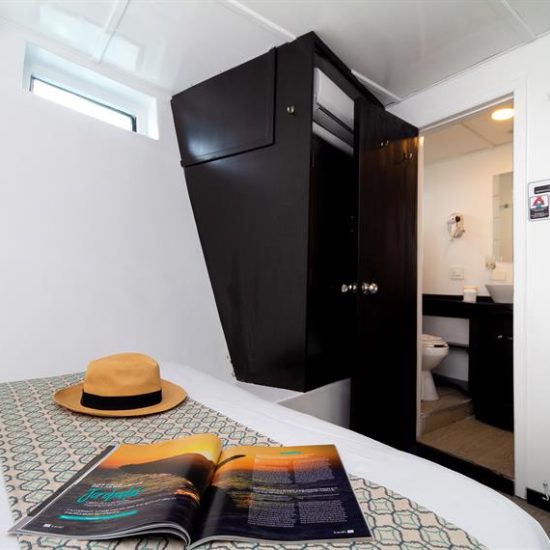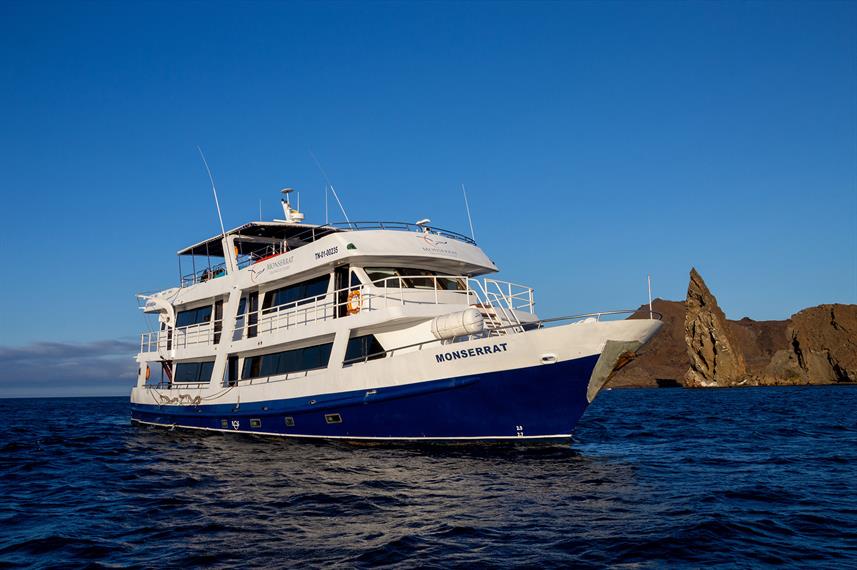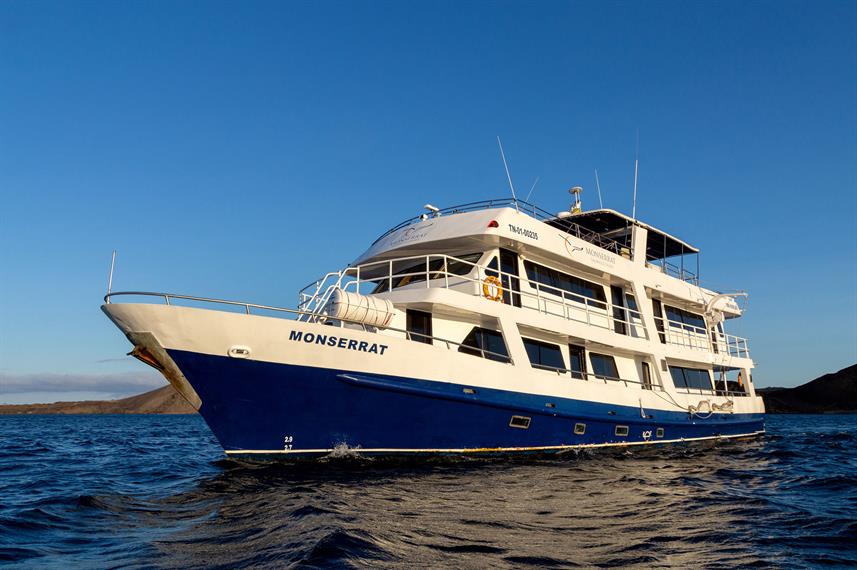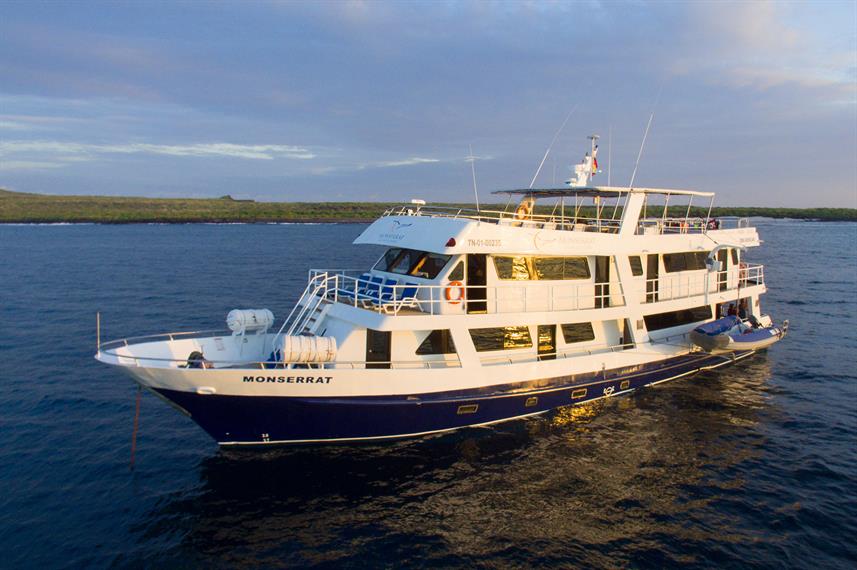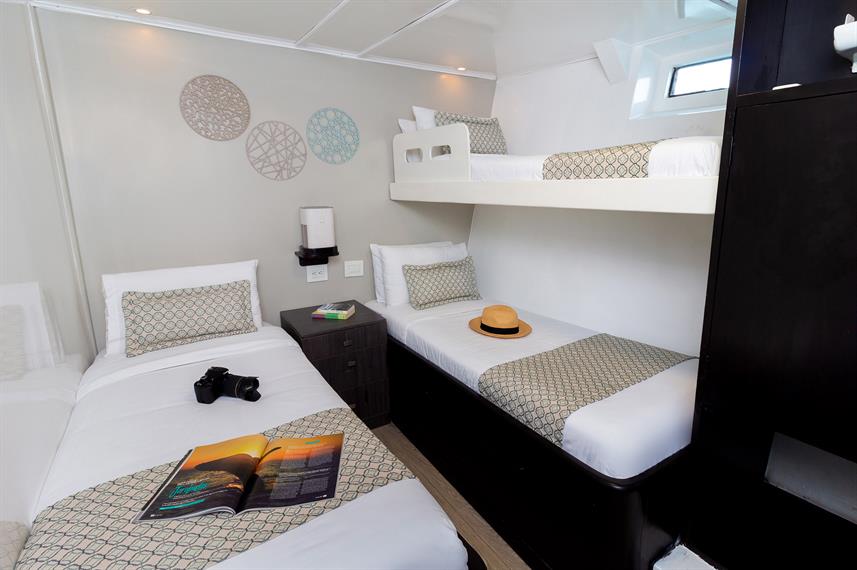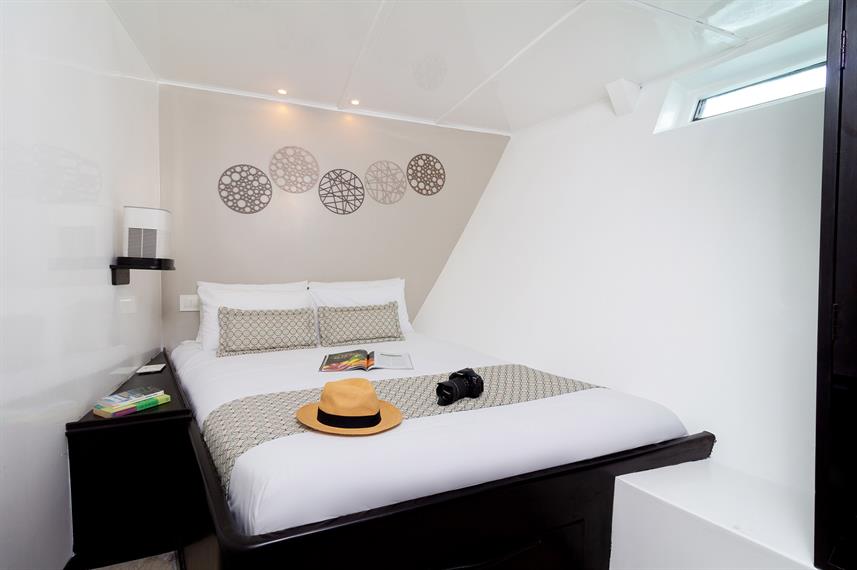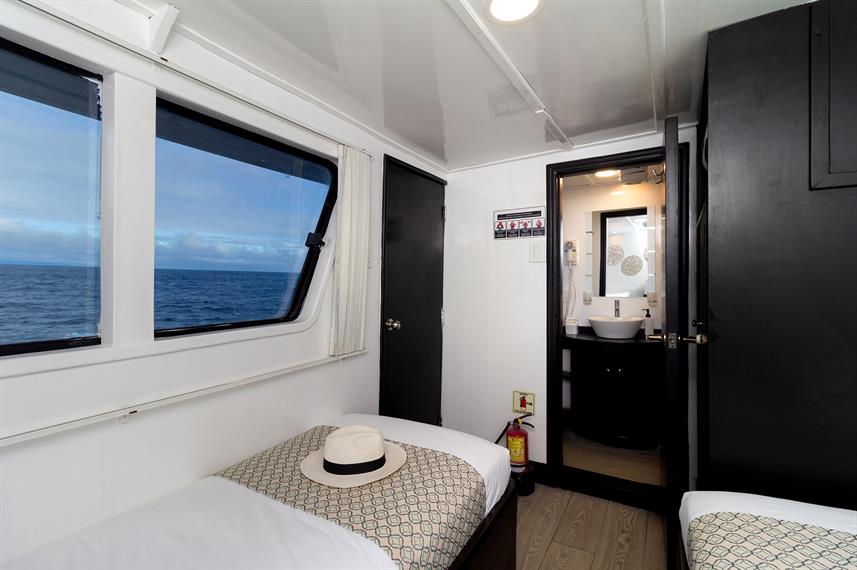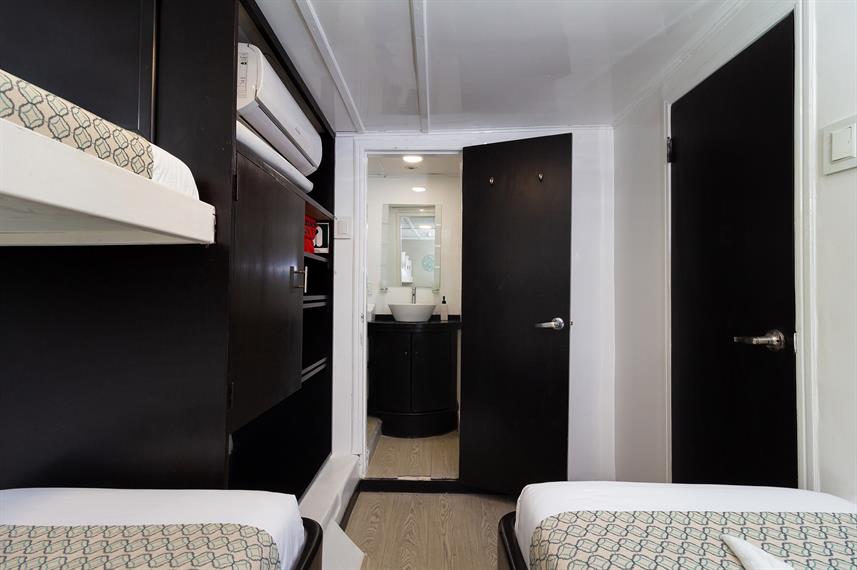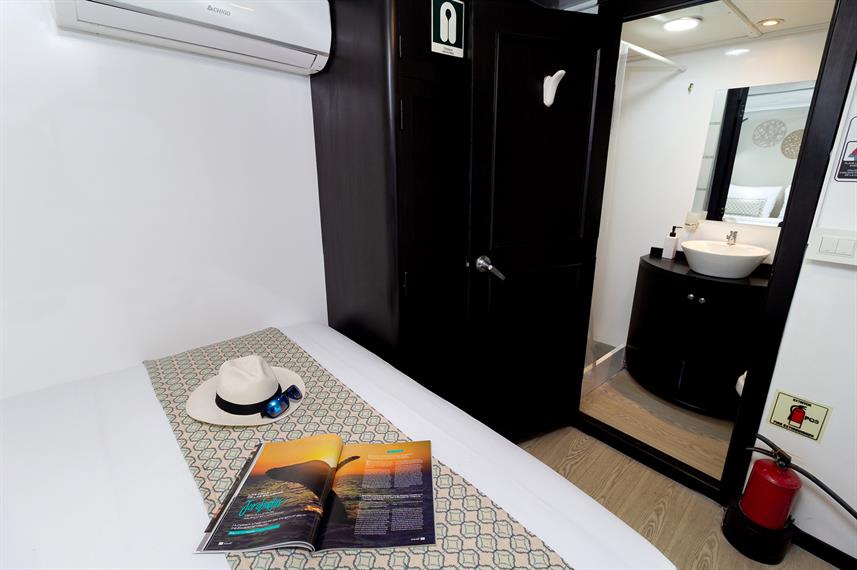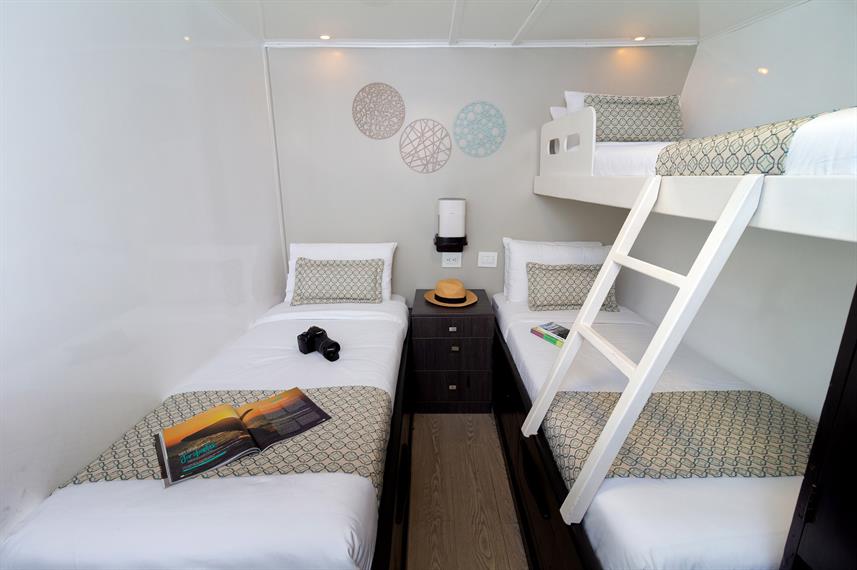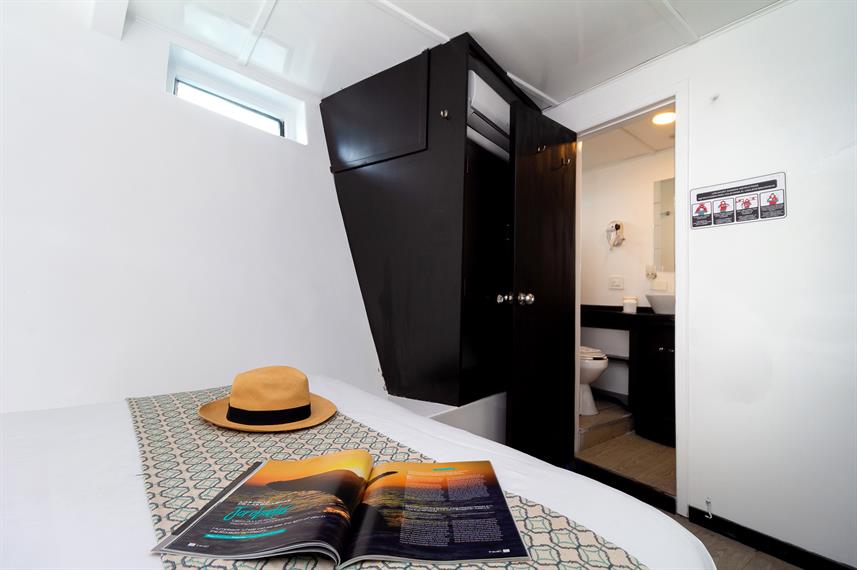Monserrat Yacht
The M/Y Monserrat is a 28-meter/91-foot long boat taking 20 passengers in 10 cabins (8 doubles and 2 doubles/triples) on adventure cruises in Galapagos. All cabins are air-conditioned and are equipped with a safe, a hair dryer, a wardrobe, and private bathrooms. The Monserrat has a passenger-to-guide ratio of 10 to 1, one of the highest in the archipelago, guaranteeing more detailed explanations during the excursions when operating at full capacity. The M/Y Monserrat also offers guests various activities, like land hikes led by knowledgeable naturalist guides and exciting snorkeling or swimming sessions. In addition, there are stand-up paddleboards and kayaks for free and cooking and cocktail lessons at no extra cost.
RESERVE THIS CRUISE
Starting Price Per Person: $2.499,00 USD, all taxes are included.
Please confirm availability for your desired itinerary by contacting us at:
info@galapagosbestoption.com / sales@galapagosbestoption.com / Whatsapp +593 967742545
PAYMENT POLICY
To book and confirm any tour, we must receive 100% of the total amount prior to the tour as follows:
50% due at the time of booking
50% due two weeks before the date of your tour
CANCELLATIONS
Any last minute cancellations or changes by the customer may incur a fee to be imposed by Galapagos Best Option SA.
If for any reason a passenger is not present at the time of their flight they will be considered a no show and will not be subject to any refund by the agency.
Please read our full Cancellation and Refund Policy.
The Galapagos National Park has the right to make any changes to the itinerary due to natural disasters or scientific research projects.
ITINERARY D
DAY 1: AIRPORT / TIJERETAS HILL/INT.CENTER (MONDAY)
San Cristóbal
Catch an early flight to San Cristóbal Island. In the afternoon, visit Tijeretas, a great viewpoint and our first wildlife encounter. Learn about the origins of the Galapagos at the Interpretation Center.
Interpretation Center Visit (PM)
San Cristóbal Island (1h-2h)
Learn about the history of the Galápagos Islands from the very beginning of their volcanic origins through to today’s conservation efforts. Tour the Human History exhibit to learn about the islands’ discovery and colonization, and discover the natural history and variety of flora and fauna that make the Galápagos so fascinating.
Tijeretas Hill (PM)
This hill bears its name thanks to the frigate birds as “Tijeretas” which is what people locally call them. Here we will enjoy a great view of beautiful landscapes at the foot of a frigate bird nesting colony.
DAY 2: BAHÍA GARDNER / PUNTA SUÁREZ (TUESDAY)
Enjoy the day on Española Island, one of the oldest in the archipelago. Visit the white sandy beach of Gardner Bay and the bird colonies of Punta Suárez. Arriving at Gardner Bay in the morning, spend the day exploring on shore and snorkeling at Gardner Island in the bay. After lunch, sail to the western side of the islands to Punta Suárez, known for its amazing bird colonies and home to the waved albatross (April and December).
Gardner Bay Visit (AM)
Bahía Gardner (1h-3h)
Visit Gardner Bay's magnificent white sandy beach, home to sea lions and sea birds. Be sure to explore the beautiful turquoise water and its incredible sea life. Spot young sea lions and large schools of surprisingly big tropical fish, including yellow-tailed surgeonfish, king angelfish, and bump-head parrot fish.
Snorkelling (Gardner Bay) (AM)
Bahía Gardner (45m-1h)
Head to Tortuga Rock and Gardner Bay for a spectacular snorkeling experience. Spot playful young sea lions and large schools of tropical fish, including yellow-tailed surgeonfish, king angelfish, and bump-head parrot fish. Look for white-tipped reef sharks napping on the bottom.
Punta Suárez Visit (PM)
Visit Punta Suárez, one of the richest wildlife landing sites in the Galápagos. Be greeted by surfing young sea lions on arrival. Head to the trail to find many species of nesting sea birds, and, if lucky, see the waved albatross. Follow the path up to a cliff for great views over the ocean, and watch sea birds gliding in the wind.
DAY 3: CORMORANT POINT/FLOREANA ISLAND (WEDNESDAY)
Land at Punta Cormorant on Floreana. Guided walks to observe the bird and wildlife and learn about the natural history. Snorkeling excursion at Champion Islet. Visit Post Office Bay.
Punta Cormorant Visit (AM)
Floreana Island
Visit Punta Cormorant, the only landing site on Floreana Island, and discover two amazingly different beaches: one with green sand, colored by olivine crystals, and another with white sand particles known as 'Flour Beach'. Spend the afternoon observing flamingos and other shore birds feeding in the lagoon. Spot penguins and marine iguanas at the water’s edge, and explore the lava tubes with the Galápagos CEO.
Snorkelling (Champion Islet) (AM)
Champion Islet
Jump on in and get up close and personal with the playful sea lion colony that resides in the waters off this tiny island. Keep an eye out for sea turtles, rays, and colorful fish swimming by. There can be currents in this area, this activity should be done by strong swimmers only.
Post Office Bay Visit (PM)
Floreana Island
Visit Post Office Bay and learn about its unique history. In the late 18th century, English whaling vessels placed a barrel here to be used as a post office. Today, the box is used mainly by tourists, who may drop off and pick up unstamped letters to be carried to far destinations. Continue the tradition – leave a letter and take one to deliver (be sure it makes it to the correct location)
DAY 4: CHARLES DARWIN STATION/HIGHLANDS (THURSDAY)
Disembark in Puerto Ayora and visit the Charles Darwin Research Station to see the giant Galápagos tortoises. In the afternoon enjoy the highlands, visit a tortoise ranch, and see some of the amazing volcanic formations in Santa Cruz.
Charles Darwin Research Station Visit (AM)
Puerto Ayora (45m)
Visit Fausto Llerena Breeding Center a great place to observe many species of tortoises and land iguanas in captivity. Brought back from the brink of extinction, see the famous Galápagos tortoise up close – a corral houses adult tortoises, and a nursery cares for the young until around age three when their shells have hardened. This area also houses the Charles Darwin Research Station, a scientific organization initiated in 1964, which works to preserve the Galápagos' ecosystem through the conservation efforts of scientists, researchers, and volunteers. While the offices themselves are not open to visitors, the research station provides a study location for international scientists and environmental education for the local community.
Santa Cruz Highlands Excursion (PM) (2h-3h)
Visit the highlands of Santa Cruz and see the Galápagos giant tortoise in its natural surroundings. Explore the area and its incredible underground lava tunnels – some are more than 1km (.6 mi) long! Wander along the volcanic tubes and keep an eye out for the (mainly) nocturnal barn owls that sometimes roost here.
DAY 5: DRAGON HILL / CHINESE HAT (FRIDAY)
This morning we visit Dragon Hill on the west coast of Santa Cruz to see land Iguanas and a saltwater lagoon frequented by flamingos and other species of birds. In the afternoon, the boat arrives at a small uniquely shaped island off the southern tip of Santiago called Chinese Hat. Here it is often possible to see galápagos penguins, and the marine life is fantastic for snorkeling. There is also a large sea lion colony as well as many marine iguanas that can be seen while walking amongst the volcanic scenery. Trek to see good views of the island's volcano.
Dragon Hill (AM) (1h-3h)
Visit Cerro Dragón (Dragon Hill) for some prime birdwatching. Take a short walk from the beach to a hypersaline (saltier than the ocean) lagoon frequented by pink flamingos, common stilts, pintail ducks, and other species of birds. Pass through a Scalesia tree forest; endemic to the area, there are only 400 specimens of Scalesia trees left in the world.
Chinese Hat Visit (PM) (1h-2h)
Explore Chinese Hat’s beautiful landscape and spectacular white-coral sand beach followed by snorkeling with sea lions and penguins and swimming opportunities in the cove.
Snorkelling (Chinese Hat) (PM)
Chinese Hat (45m-1h)
Snorkel right from the white-coral sand beach and come face to face with playful sea lions and large schools of tropical fish. Keep an eye out for marine iguanas and penguins too!
DAY 6: EL BARRANCO / DARWIN BAY (SATURDAY)
Today we will be visiting the beautiful and remote Genovesa Island. This northern island, famous for its red-footed colony, is a paradise for bird lovers. It is estimated that about 200,00 Red-footed boobies live on this island.
Prince Phillips’s Steps (AM) (2h)
El Barranco or Prince Phillips’s Steps as otherwise known was named after a visit by the British Monarch in 1964. El Barranco's steep 81-foot stairway leads up to a high cliff face that opens out onto the plateau surrounding Darwin Bay. Here an amazing view can be appreciated. Once at the top of the stairway, we will meet Nazca boobies, red-footed boobies, mockingbirds, and finches along the way to a palo santo trail. It will also be possible to see wedge-rumped storm petrels swarm and short-eared owls.
Darwin Bay (PM) (1 ½h)
Darwin bay was formed by the collapse of the flooded caldera of Tower Island, another name used for Genovesa. After landing at a small sand and coral beach, it is easy to realize why this island is a bird-lover paradise. Among the bird species found here, the most common are swallow-tailed and lava gulls, mockingbirds, yellow-crowned night herons, lava herons, Galapagos doves, and yellow warblers. We will continue on a short and flat trail to encounter red-footed booby and great frigatebird nests. We will visit a tidal lagoon where sea lions swim playfully ending our path on a cliff with magnificent views of this remote part of the Galapagos.
DAY 7: BLACK TURTLE COVE / BALTRA ISLAND (SUNDAY)
Baltra
Take a morning panga ride and look for marine life in Black Turtle Cove. Disembark at Baltra and fly back to Ecuador's mainland.
Black Turtle Cove Excursion (AM)
Black Turtle Cove
Explore the mangroves by panga to find rich marine wildlife between the fresh and salt waters. Keep an eye out for manta rays and sea turtles in this tranquil ecosystem. Whitetip reef sharks can also be seen gliding by.
PRICE : 3.749,00 USD P.P.
ITINERARY A
DAY 1: BALTRA / BACHAS BEACH (SUNDAY)
Baltra
Flight to Baltra Island. You will be met by our guide and transferred to the Monserrat. We will then sail to Bachas Beach where our first exploration of the Galapagos begins. Bachas is a great introduction to the Galapagos. Here you can relax and swim in its crystalline waters. This site also allows visitors to see frigatebirds, blue-footed boobies, and sea lions.
Bachas Beach Landing (PM)
Bachas Beach (2h)
Head to Bachas Beach where the sand is made of decomposed coral, making it soft and white, and a favorite site for nesting sea turtles. Spot abundant Sally Lightfoot crabs on the lava rocks along the water's edge -- these crabs will eat anything they can get their claws on! Trek to see a wide range of wildlife, including flamingos, hermit crabs, black-necked stilts, and sea lions.
Snorkeling (AM)
Bachas Beach (45m-1h)
Go snorkeling or swimming right off the white sand beach of Las Bachas. Spot all sorts of marine wildlife in its shallow waters and tidal pools. Bachas is also one of the most important beaches for the green turtle as a nesting site.
DAY 2: TAGUS COVE / URBINA BAY (MONDAY)
After a long journey from the central part of the Galapagos, we will arrive at the pristine and remote West of the archipelago. Our visits today are Tagus Cove and Urbina Bay on the west of Isabela Island, where we will have our first encounters with flightless cormorants, penguins, giant tortoises and beautiful landscapes, and amazing snorkeling opportunities.
Tagus Cove (AM)
Tagus Cove is located on the Northwestern coast of Isabela. It is a historical site visited by Charles Darwin in 1835, where graffiti has been carved into the rock walls by visitors over the past centuries. This spot has been frequented by whalers and pirates since the 1800s that used the area as anchorage. The name of the site dates back to 1814 when it was visited by a British ship, The Tagus, which had anchored there in search of giant tortoises to be used as a food supply on the boat.
Here, we will admire a variety of seabirds, such as blue-footed booby, brown noddy, terns, the flightless cormorant, and Galapagos penguins depending on the season. Occasionally you might see woodpecker finches, the Galapagos hawk, the yellow warbler, or a large-billed flycatcher. After a dry landing, we can climb up the trail to visit Darwin's Lake. The lake is located on the slopes of Darwin Volcano and is, surprisingly, a salt water lake above sea level. Our naturalist guide will tell you what are the different scientific theories for this occurrence. Meanwhile, in our snorkeling, there are chances to see sharks, turtles, and sea stars. You may also see various types of colorful fish.
Urbina Bay (PM)
Urbina Bay is a fascinating visitor site that came to be as the shallow sea bottom uplifted in 1954 showing a large coral reef sticking up above sea level. Because of this, Urbina Bay is one of the newest features in the Galapagos. This visitor site is located west of Isabela and provides spectacular views of the Alcedo volcano. The long trail starts on the beach where a wet landing is made. In this location, you will likely see wild Galapagos Giant Tortoises and Galapagos Land Iguanas. As the trail circles back towards the shore line you'll come across colonies of the unique Galapagos Flightless Cormorant which lost its ability to fly. This is also a great spot for snorkeling, as you can come close to a Galapagos Penguin Colony and see Galapagos Marine Iguanas feeding underwater.
DAY 3: ESPINOZA POINT / VICENTE ROCA POINT (TUESDAY)
Today we visit the most western visitor site of the Galapagos, Espinoza Point in Fernandina Island. This island is also one the most pristine on the archipelago as no foreign species have been introduced. In the afternoon, we will visit Vicente Roca Point, on Isabela Island, famous for its rich underwater sea life thanks to its location on the Bolivar Channel.
Espinoza Point (AM)
Espinosa Point on Fernandina Island is one of the most pristine islands in the world, with none of man’s introduced species to date. From here we can see the island of Isabela across the Bolívar Channel, an area that boasts some of the highest diversity of endemic sea fauna in the Galapagos. Fernandina is the youngest of the Galapagos Islands and a visitor favorite.
When landing, check out the tidal pools where sea life is abundant, including small fish and mollusks. If we are lucky, a sea turtle or ray may be trapped in the pools. A little further ahead we will pass through some marine iguana burrows and sea lion colonies. The trail continues to where several flightless cormorants have their nests. This remarkable bird is only found in the western Galapagos, and experts estimate that they may only be a few hundred individuals in total.
Vicente Roca Point (PM)
Vicente Roca Point has great deep-water snorkeling at one of the richest marine havens on Earth (Bolivar Channel). Vicente Roca Point is renowned for its Galápagos green turtles, which are very numerous on the bay. Although the spot is known for its high concentration of green turtles, sharks, and rays can also be observed when underwater visibility is good. We take a dinghy ride along the coast to observe a great diversity of sea and coastal birds; Nazca and blue-footed boobies, noddies, brown pelicans, penguins, and flightless cormorants. The upwelling of coldwater currents in this part of the Galapagos gives rise to an abundance of marine life. Our snorkeling will take us along the cliffs and offers the chance of exploring two shallow underwater caves with rich marine wildlife.
DAY 4: PUERTO EGAS / BUCCANEER COVE (WEDNESDAY)
Morning excursion to Puerto Egas to see the salt crater as well as a dark sand beach and tidal pools. Continue to Playa Espumilla, one of the most idyllic beaches in the Galápagos Islands, which boasts thick mangroves and flamingo and sea turtle nesting sites. Head to Buccaneer Cove to witness the towering cliff wall rock formations. Santiago Island has seen its share of human activity from whalers and pirates over the years, and despite the introduction of goats to the island many years ago, the wildlife of Santiago has otherwise flourished and provides outstanding viewing opportunities. The island boasts marine iguanas, sea lions, fur seals, and land and sea turtles, among others. Enjoy great wildlife viewing both on land and in the water.
Puerto Egas Visit (AM)
Puerto Egas
Explore the spectacular shoreline of Puerto Egas, also known as James Bay. Spot a great number of shore birds and reptiles – the beach area is home to a plethora of wildlife.
Snorkeling (Puerto Egas) (AM)
Puerto Egas (45m-1h)
Grab a snorkel and jump into the water right off the beach to explore Puerto Egas' interesting underwater world. Keep your eyes peeled for rays, turtles, and reef sharks while snorkelling. After, visit the large tidal pool area – marine iguanas and Sally Lightfoot crabs are everywhere.
Playa Espumilla Excursion (PM)
Playa Espumilla
Head to Playa Espumilla, one of the most idyllic beaches in the Galápagos Islands, which has thick mangroves and sea turtle nesting sites.
Buccaneer Cove Visit (PM)
Jump into the panga and cruise alongside high cliffs and rock formations on this visit to Buccaneer Cove, which was a favorite hideout for pirates looking to stock up their boats with food and water. Spot sea lions relaxing on the beach and sea birds nesting in the cove – there are lots to see at this site.
DAY 5 NORTH SEYMOUR / BALTRA AIRPORT (THURSDAY)
Baltra
Visit North Seymour for guided walks to observe birds and wildlife, including vast sea lion colonies. Disembark at Baltra for a flight back to Ecuador's mainland.
North Seymour Island Visit (AM)
Have an amazing wildlife experience visiting North Seymour Island – this island is teeming with life! Follow trails to see all the action (you may need to give way to a passing sea lion or marine iguana while walking). See blue-footed booby nests where mating pairs perform their courtship dance. Head to a rocky shore to see flocks of pelicans having lunch in a dive bomb-feeding frenzy, then turn inland to a large nesting site of magnificent frigate birds. These huge, dark acrobats have two-metre (6.5 ft) wingspans, and males, with their puffed-up scarlet throat sacks, sit precariously perched in low bushes to watch over their equally large chicks. Top off the excursion with a snorkel among sea lions and rays.
PRICE : 3.349,00 USD P.P.
ITINERARY B
DAY 1: BALTRA AIRPORT/ SANTA CRUZ ISLAND (THURSDAY)
BaltraTransfer to the boat to meet the guide and get on board. In the afternoon, enjoy the highlands. Visit a tortoise ranch and see some of the amazing volcanic formations in Santa Cruz.
Santa Cruz Highlands Excursion (PM)
Santa Cruz Island (2h-3h)
Visit the highlands of Santa Cruz and see the Galápagos giant tortoise in its natural surroundings. Explore the area and its incredible underground lava tunnels – some are more than 1km (.6 mi) long! Wander along the volcanic tubes and keep an eye out for the (mainly) nocturnal barn owls that sometimes roost here.
DAY 2: RÁBIDA ISLAND / BARTOLOMÉ ISLAND (FRIDAY)
This morning you will have an excursion to Rábida its unique reddish landscape, to see a lagoon and a sea lion colony. Continue to Bartolomé for a guided tour to see the dramatic volcanic features before hiking to a panoramic viewpoint.
Rabida Island Excursion (AM)
Arrive at a red sand beach at Rábida to explore its trails. A short trail leads to a saltwater lagoon; another trail goes past the lagoon to the interior, where the revered palo santo trees grow. (When burned, the branches of this tree give off a pleasing aroma and ward off mosquitoes.) Head back to the beach to see prehistoric-looking pelicans nesting among low-lying bushes – it's a rare treat to watch parent pelicans return with gullets full of fish for the squawking youngsters.
Snorkelling (Isla Rábida) (AM)
Rábida Island (45m-1h)
Take a panga ride from the beach to a cliff wall that drops off into the water to find one of the best deep-water snorkeling spots on the islands.
Bartolomé Island Landing (PM)
Bartolomé Island
Hike to Bartolomé's summit for a stronger perspective of the islands' not-too-distant volcanic origins, and enjoy a panoramic view – it’s one of the best among the islands! See other Galápagos Islands in the distance as well as Pinnacle Rock, the island’s famous towering landmark.
Snorkelling (Bartolomé Island) (PM)
Bartolomé Island (45m-1h)
Take the opportunity to swim and snorkel around Pinnacle Rock, one of the most iconic volcanic rock formations on the islands. Home to Galápagos penguins, friendly sea lions, sea turtles, and a huge variety of fish, Bartolomé and its surrounding waters are a fantastic place to explore the natural wonders of the Galápagos.
DAY 3: ISLAS PLAZA / SANTA FÉ ISLAND (SATURDAY)
Land at South Plaza in the morning for wildlife spotting opportunities and a walk through the cactus forest. In the afternoon, take a guided walk around Santa Fé to observe wildlife and plentiful marine iguanas.
South Plaza Island Visit (AM)
South Plaza
Visit South Plaza, one of the smallest islands in the Galápagos, which has one of the largest populations of land iguanas. Walk along a path through a cactus forest and view a combination of dry and coastal vegetation on this lively island, home to a wide range of fauna, including incredible birdlife. Spot red-billed tropicbirds and indigenous swallow-tailed gulls resting on the cliffs, and sea lions playing in the waters.
Sante Fé Hiking (PM)
Santa Fé Island
Lace up your hiking boats to explore the island's flora and fauna. Trek toward the cliffs along the island's northern shore to see a forest of giant prickly pear cacti (Opuntia). See endemic land iguanas lounging in their favorite forest, and feasting on Opuntia pads and fruit.
DAY 4: PUNTA PITT / CERRO BRUJO (SUNDAY)
Morning landing at Punta Pitt on San Cristóbal Island to observe the marine iguanas and seabirds along the beach and enjoy a snorkeling excursion. In the afternoon, you'll and at Cerro Brujo to observe the sea lions, marine iguanas, and seabirds along the beach.
Punta Pitt Visit (AM)
Punta Pitt
Enjoy amazing wildlife watching and interesting geological formations on this fascinating expedition. Arrive at a quiet cove on the eastern tip of San Cristóbal to explore Punta Pitt. Made up of volcanic tuff substrate, it's the only site in the Galápagos where it's possible to see three species of boobies and two species of frigatebirds.
Snorkelling (Punta Pitt) (AM)
Punta Pitt
Snorkel around Punta Pitt Island and spot schools of fish swimming below. On the shore admire the nesting birds and sunbathing sea lions.
Cerro Brujo Visit (PM)
Cerro Brujo (1h-3h)
Visit Cerro Brujo to explore its coastline, and look for wildlife on the beach, in the water, and in the air. Learn about the human and natural history of the area from the Galápagos CEO. Take a refreshing dip in the turquoise water, and head out on a short walk to a freshwater lagoon – a great place to see flamingos.
DAY 5: LOBOS ISLAND / SAN CRISTOBAL AIRPORT (MONDAY)
In the morning, visit Isla Lobos and be greeted by sea lions frolicking in the waves before being transferred to Puerto Baquerizo Moreno airport.
Isla Lobos Visit (AM)
Isla Lobos
Explore this tiny island by foot and boat for some great wildlife encounters. Take a panga ride to view the sea and shore birds nesting and feeding. Spot a small colony of blue-footed boobies as well as two species of sea lions.
PRICE : 2.949,00 USD P.P.
ITINERARY D
DAY 1: BALTRA ISLAND / SANTA CRUZ ISLAND (THURSDAY)
Baltra
Transfer to the boat to meet the guide and get on board. In the afternoon enjoy the highlands, visit a tortoise ranch, and see some of the amazing volcanic formations in Santa Cruz.
Santa Cruz Highlands Excursion (PM) (2h-3h)
Visit the highlands of Santa Cruz and see the Galápagos giant tortoise in its natural surroundings. Explore the area and its incredible underground lava tunnels – some are more than 1km (.6 mi) long! Wander along the volcanic tubes and keep an eye out for the (mainly) nocturnal barn owls that sometimes roost here.
DAY 2: DRAGON HILL / CHINESE HAT (FRIDAY)
This morning we visit Dragon Hill on the west coast of Santa Cruz to see land Iguanas and a saltwater lagoon frequented by flamingos and other species of birds. In the afternoon, the boat arrives at a small uniquely shaped island off the southern tip of Santiago called Chinese Hat. Here it is often possible to see galápagos penguins, and the marine life is fantastic for snorkeling. There is also a large sea lion colony as well as many marine iguanas that can be seen while walking amongst the volcanic scenery. Trek to see good views of the island's volcano.
Dragon Hill (AM) (1h-3h)
Visit Cerro Dragón (Dragon Hill) for some prime birdwatching. Take a short walk from the beach to a hypersaline (saltier than the ocean) lagoon frequented by pink flamingos, common stilts, pintail ducks, and other species of birds. Pass through a Scalesia tree forest; endemic to the area, there are only 400 specimens of Scalesia trees left in the world.
Chinese Hat Visit (PM) (1h-2h)
Explore Chinese Hat’s beautiful landscape and spectacular white-coral sand beach followed by snorkeling with sea lions and penguins and swimming opportunities in the cove. Snorkelling (Chinese Hat) (PM)
Chinese Hat (45m-1h)
Snorkel right from the white-coral sand beach and come face to face with playful sea lions and large schools of tropical fish. Keep an eye out for marine iguanas and penguins too!
DAY 3: EL BARRANCO / DARWIN BAY (SATURDAY)
Today we will be visiting the beautiful and remote Genovesa Island. This northern island, famous for its red-footed colony, is a paradise for bird lovers. It is estimated that about 200,00 Red-footed boobies live on this island.
Prince Phillips’s Steps (AM) (2h)
El Barranco or Prince Phillips’s Steps as otherwise known was named after a visit by the British Monarch in 1964. El Barranco's steep 81-foot stairway leads up to a high cliff face that opens out onto the plateau surrounding Darwin Bay. Here an amazing view can be appreciated. Once at the top of the stairway, we will meet Nazca boobies, red-footed boobies, mockingbirds, and finches along the way to a palo santo trail. It will also be possible to see wedge-rumped storm petrels swarm and short-eared owls.
Darwin Bay (PM) (1 ½h)
Darwin bay was formed by the collapse of the flooded caldera of Tower Island, another name used for Genovesa. After landing at a small sand and coral beach, it is easy to realize why this island is a bird-lover paradise. Among the bird species found here, the most common are swallow-tailed and lava gulls, mockingbirds, yellow-crowned night herons, lava herons, Galapagos doves, and yellow warblers. We will continue on a short and flat trail to encounter red- footed booby and great frigatebird nests. We will visit a tidal lagoon where sea lions swim playfully ending our path on a cliff with magnificent views of this remote part of the Galapagos.
DAY 4: BLACK TURTLE COVE / BALTRA ISLAND (SUNDAY)
Baltra
Take a morning panga ride and look for marine life in Black Turtle Cove. Disembark at Baltra and fly back to Ecuador's mainland.
Black Turtle Cove Excursion (AM)
Black Turtle Cove
Explore the mangroves by panga to find rich marine wildlife between the fresh and salt waters. Keep an eye out for manta rays and sea turtles in this tranquil ecosystem. Whitetip reef sharks can also be seen gliding by.
PRICE : 2.949,00 P.P.
- Airport Transfers
- Naturalist Guide Certified by the Galapagos National Park
- Full Meals
- Coffee, Tea and Snacks
- Snorkel Gear (Mask, Fins and Snorkel)
- Wetsuit
- Private Bathroom With Hot Water
- Air Conditioning
- Entrance Fee to Galapagos National Park $100 USD
- Immigration Control Card $20 USD
- Personal Expenses
- Tips for the Crew and Guide
- Galapagos Flights ($450 to $550 USD – ask us for a quote!)
- Alcoholic Beverages and Soft Drinks
